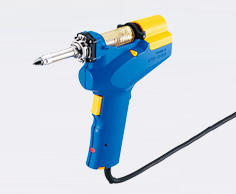GeoPeg posted:PLCProf posted:I would not buy/use one of these for average home repairs, they are meant for high volume production. They are expensive to purchase and can be costly to maintain. We used similar solder suckers in our pcb repair lab and anywhere from 3 to 5 rework techs would be working on just component replacement all day long. For that, they are much faster and totally appropriate. But even with this useful tool, the techs first cut the legs off chips they were replacing with flush cutters - this makes removal a lot easier and quicker.
My personal recommendation for home use is the manual $10-$20 solder sucker. They do a good job, especially when followed with solder wick (braid) to do a cleanup on the solder pads - we used a lot of solder wick for just that purpose. The techs would literally "skate" the solder pencil atop the solder wick down an entire row of IC leg pads and clean them quickly and safely. The secret is to keep the solder wick moving - you probably won't ever tear any pads if you can manage that.
Also, we always cleaned up all newly soldered connections with Flux-Off to get rid of resin (from the solder) and general crud. It's useful because it allows you to see the connection better after completion, to insure it doesn't look cold, no bridges, etc. Some say the resin, if left on the board, can cause corrosion of the traces but I think it's more of a "looks" thing. If you don't want to use harsh chemicals for cleanup, just use a tooth brush and alcohol - takes just a bit of scrubbing, and it works best if things are still warm, but it's cheaper and safer.
This model is not really made for high rework. It is intended for the hobbits and on the go person.






